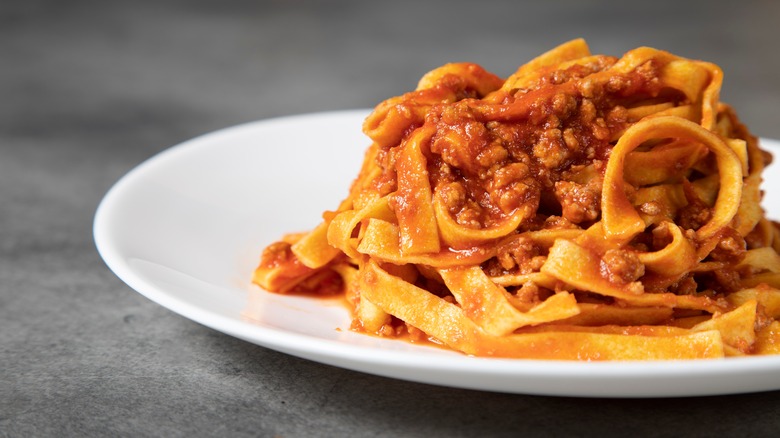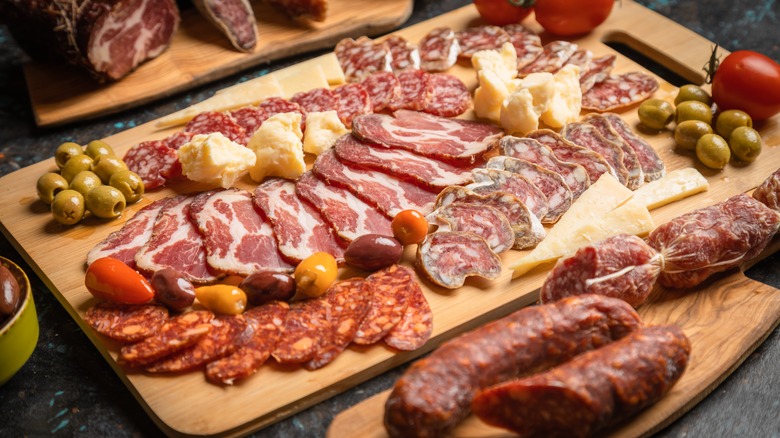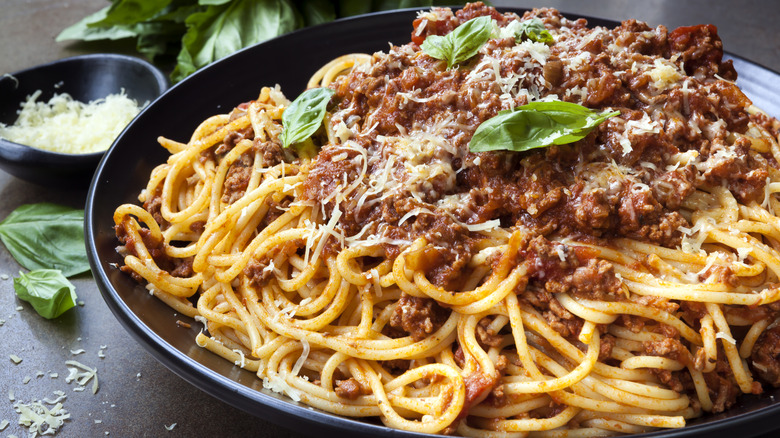The Secret To Perfectly Rich Bolognese Is Leftover Charcuterie Meats
We may receive a commission on purchases made from links.
Bolognese is a classic Italian meat sauce. But it's not an ordinary sauce. It is thick and creamy and very rich. And unlike many pasta sauces from Italy, the traditional version doesn't use tomatoes. It is made from a soffritto of onion, carrot, and celery, the basis for many Italian recipes, with different types of meat. Wine, chicken stock, and herbs are added, and the sauce is simmered for hours until it's thick and rich.
There are probably as many recipes for bolognese as there are Italian citizens. You can find tomato-rich recipes, of course, and some recipes use veal and beef, pork sausage and beef, or pancetta and beef. And of course, as in all European countries where food is critically important, there is an actual official recipe for Bolognese from Accademia Italiana Della Cucina (which, surprisingly, does use tomatoes). And there's an extra, unexpected ingredient in bolognese sauce — milk! The milk adds creaminess and softens the acidity of the tomatoes and vegetables.
But if you don't live in Italy and have access to its excellent produce and savory meats, can you still make a great Bolognese? Yes! The secret to perfectly rich bolognese is leftover charcuterie meats, per Food & Wine.
Charcuterie meats for a flavor win
Charcuterie means cold-cooked or preserved meats. A charcuterie board, which has become very popular for entertaining recently, is made of cold, cooked, smoked, and highly spiced fatty meats, including prosciutto, thinly sliced ham (preferably jamón Ibérico from Portugal), guanciale (a type of pancetta with more fat), bresaola (a spicy bright red cured beef roast), mortadella, soppressata, and even chorizo and kielbasa.
Why are these meats good in bolognese? For one, they are fatty. Research has found that fat should be considered the sixth taste (after sweet, sour, bitter, salty, and umami) because it "evokes a unique sensation satisfying another element of the criteria for what constitutes a basic taste," according to Purdue University researchers. And most herbs and spices are more potent when cooked with fat, according to America's Test Kitchen, so that the sauce will be more flavorful.
Fat also adds a wonderfully rich texture, or mouthfeel, per Popular Science, which makes the sauce taste silky and creamy. These meats are highly seasoned, which perks up the sauce without any extra effort.
Make the best bolognese ever
So, which charcuterie meats should you choose? It depends on how you want your sauce to taste. Saltier meats include ham and prosciutto. Soppressta is spicy while pancetta and guanciale are fattier, per MasterClass. You can mix these meats with ground beef or ground pork to make the perfect base for your bolognese sauce. The point is to use your favorites.
It's essential that the meats are finely chopped because getting a bite of guanciale in your bolognese would ruin the flavor. Chopping them lets their flavors and fat meld with the sauce, making each bite delectable. Cook each meat, and reserve the liquid for your sauce.
Now that you know the secret to the best bolognese, try it yourself. Make pasta with bolognese sauce, adding your own secret blend of charcuterie meats. And don't forget the red checked tablecloth and candles in wine bottles!


